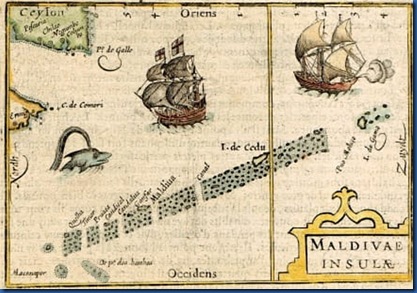One of the blog features has been a dive into the colourful linguistic tapestry of this exotic land (and sea). The resort database includes a field for the Dhivehi meaning of all the resort names as well. So I especially enjoyed this piece in the Maldive Independent – “What’s in a name: Maldives throughout millennia” – which explored the etymology of the name “Maldives” itself as well as a variety of other monikers it had through the centuries:
- 1500-500 BC: “Maladvipa”, (“Mala” meaning garland and “Dvīpa” meaning island) in Vedic literature including the Mahābhārata and Purāṇas.
- 483 BC: “2000 Parittadipa” (small islands) by the Buddhist Pāli texts Aṅguttara Nikāya and Khuddaka Pāṭha.
- 59-62 AD: “Coral Islands” by Greco-Roman periplus, Periplus of the Erythraean Sea written in Koine Greek describing sea navigation and trading routes.
- 150 AD: “Manioli” by Claudius Ptolemy’s Geographia (Book 7, Chapter 4) describing “1378” islands located southwest of India.
- 420 AD: “Islands beyond India” referenced by Bishop Palladius of Helenopolis in Historia Lausiaca.
- 5th century AD: “Mahiladipika” (Island of Women) by linguist Wilhelm Geiger derived from the Pali words Mahila (woman) and Deepika (islands), reflecting a matriarchal order.
- 7th century AD: “Dweepa Lakshman” (Hundred Thousand Isles) byPallava dynasty documents.
- 658 AD: “Mo-lai people” by Tang Dynasty records.
- 9th century AD: “Diva Kauza” (“Islands of Shells”) by Iraqi merchant and writer Diva Kauza (Islands of Shells).
- 10th century AD: “Munnir Palantivu Pannirayiram” (Twelve Thousand Islands and the Ocean Where Three Waters Meet), referring to the Arabian Sea, Indian Ocean, and the Bay of Bengal by Chola dynasty inscriptions.
- 12th century AD: “Dheebat al Mahal” (“Islands of Women”) by Arabic historians Al-Masudi, Sulaiman al-Tajir, Al-Biruni.
- 1225 AD: “Liu Shan” (Island Country) or “Liu Shan Guo” (Country of the Flowing Mountains) by Chinese customs inspector and geographer Zhao Rugua (1170–1228 CE), of the Song Dynastry period in his work Zhu Fan Zhi (Description of Barbarian Nations or Records of Foreign Peoples).
- 13th century AD: “Pāpalam Theevu” (Pāpalam meaning cowries shells and Theevu meaning island in Tamil). Tholkāppiyam, by Tholkāppiyam the oldest extant work in Tamil literature.
- 1300 AD: “Island of Male” by Marco Polo (referenced, not visited).
- 1343-46 AD: “Deebath Al Mahal” by Ibn Battuta.
- 1414 AD: “Liu Shan Tieh Kan” (Islands of Peaks) by Chinese admiral Zheng He’s scribe, Ma Huan, while Fei Xin, who also accompanied the commander names it “Liu Shen Yeng” (roughly translates into “Divine or Mysterious islands in the vast ocean or across the sea).
- 1507 AD: “Maldives Ilha Dywe” by Portuguese explorers.

